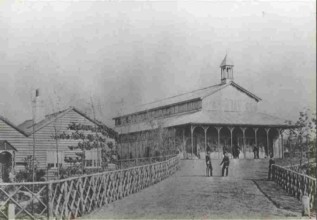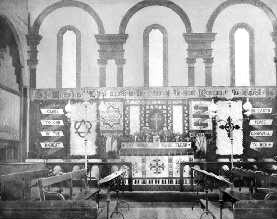Acknowledgment
The first three pages of the history section of this web site reproduce text from "St Andrew’s Garrison Church of Scotland, Aldershot, A Short History" (1967) by David Reid, F.S.A.Scot., C.F. In a few places David Reid’s original text has been updated as a result of the discovery of new archival information - where that occurs the amended text appears in bold and italics. St. Andrew’s Garrison Church would like to thank David Reid for kindly granting permission to publish this article on this website.
1854-1927 “The Iron Church”
The original camp at Aldershot, consisting of lines of wooden huts, was established in 1854. It was divided into two, the North and South Camps; the boundary line being the Basingstoke Canal.
Military church history in Aldershot began in this way: - a letter, dated 1st Dec. 1854, from the Committee on the Aldershot Encampment states, inter alia, that the Committee "are desirous of bringing under His Lordship’s (Viscount Hardinge’s) consideration the propriety of a Chapel for the troops being erected at Aldershot with a residence for an Army Chaplain". The reply to this was as follows, "With regard to the Chapel Lord Hardinge considers the question of its construction as well as of a residence for the Chaplain may be postponed for the present reserving a site for the purpose". The postponement was short and a letter from the Ordnance Board to the Inspector-General of Fortifications, dated 14th April 1855, directed that two churches (officially designated "Chapel Schools") were to be built to cater for the spiritual needs of the new Aldershot Camp. It states, "The buildings are to be erected on the plan of a covered railway station, and are to have no galleries and nothing in them except forms".
In 1856 another church was found to be necessary and it was built in that year. In this one a gallery was permitted. There is a legend that this church was originally intended as a prefabricated hospital for Florence Nightingale in the Crimea. There is nothing in the records to show that this was so, but the legend is persistent. The "Glasgow Herald" quoted another version of the legend in its issue of the 10th Dec. 1927, when it said, "There is a tradition that the iron building was in use as a hospital in the Crimea, and that Florence Nightingale tended wounded within its walls".
Military church history in Aldershot began in this way: - a letter, dated 1st Dec. 1854, from the Committee on the Aldershot Encampment states, inter alia, that the Committee "are desirous of bringing under His Lordship’s (Viscount Hardinge’s) consideration the propriety of a Chapel for the troops being erected at Aldershot with a residence for an Army Chaplain". The reply to this was as follows, "With regard to the Chapel Lord Hardinge considers the question of its construction as well as of a residence for the Chaplain may be postponed for the present reserving a site for the purpose". The postponement was short and a letter from the Ordnance Board to the Inspector-General of Fortifications, dated 14th April 1855, directed that two churches (officially designated "Chapel Schools") were to be built to cater for the spiritual needs of the new Aldershot Camp. It states, "The buildings are to be erected on the plan of a covered railway station, and are to have no galleries and nothing in them except forms".
In 1856 another church was found to be necessary and it was built in that year. In this one a gallery was permitted. There is a legend that this church was originally intended as a prefabricated hospital for Florence Nightingale in the Crimea. There is nothing in the records to show that this was so, but the legend is persistent. The "Glasgow Herald" quoted another version of the legend in its issue of the 10th Dec. 1927, when it said, "There is a tradition that the iron building was in use as a hospital in the Crimea, and that Florence Nightingale tended wounded within its walls".


The
Iron Church - outside & inside
This third church became known to the troops as the "Tin Tabernacle", but the name by which it is best remembered is the "Iron Church". It was built of corrugated-iron and is described in a book, written a year after it was built as, "built entirely of cast-iron (sic), with painted glass windows. It is particularly light and elegant and intended, we understand, for the Court especially."
Queen Victoria and her retinue worshipped occasionally in the "Iron Church" on her fairly frequent visits to Aldershot to review the troops and to observe "Sham Fights", as they were called.
In a short history, written in 1939 for the rededication of the present church, it is said that the "Iron Church" was built originally on the recreation ground immediately south of the present supply depot. This site is now (1967) a football pitch on Thornhill Road near the Army Catering Corps’ School of Cookery. According to records the church was transferred to Cranbrook Road (now Queen’s Avenue) in 1866, this site being more central. This move certainly bears out the assertion of the legend that the building was transportable.
In the porch of the present church there is a photograph of the "Iron Church" as it was in 1868. At the door of the "Iron Church stands Colonel Laffan, C.R.E., who was responsible for the planning and construction of the infantry barracks. Laffan’s Plain (the old Parade Ground where Queen Victoria often reviewed the troops), which is now part of the airfield to the west of the Farnborough-Farnham road, is named after him. He later became Major-General Sir Robert Laffan, K.C.M.G., Governor and Commander in Chief, Bermuda. Col. Laffan was the man responsible for the moving of the "Iron Church".
The first Church of Scotland Chaplain to serve in the "Iron Church" was the Rev. Francis Cannon. Padre Cannon was a native of Forfar and since his time (1856) the Church of Scotland has to this date (1967) had at least one minister in Aldershot Camp. The names of the Senior Chaplains of St. Andrew’s can be seen on a board on the inside of the west wall of the church. A goodly number of them rose to be Deputy Chaplain-General, which is (in 1967) the highest appointment in the Royal Army Chaplain’s Department open to Chaplains of the Church of Scotland.
One of the Senior Scottish Chaplains, the Rev. John MacTaggart (Chaplain in St. Andrew’s 1885-1890), owed the preservation of his life to his bible. Once when he was on active service a bullet struck him on the chest but it was stopped by the bible which he carried in his breast pocket. His family is still represented in the congregation today (1967). Indeed it was a relation of his who gifted the stained-glass window directly over the organ bay in the chancel (the Ralston memorial stained glass).
The old "Iron Church" had literary associations too. It plays a large part in "The Story of a Short Life" by Mrs. Juliana Horatia Ewing, published in 1885 by S.P.C.K. The young hero of the book lived in the wooden house which can be seen in the photograph of the "Iron Church" (see the photograph above taken in 1868 showing the iron church with a wooden house to the left of it). There is a Memorial to Mrs. Ewing (who was a Children’s Story Writer of some repute) in St. George’s Garrison Church and a signed photograph of her in St. George’s Vestry.
The "Iron Church" was used jointly by the Church of Scotland and the Church of England until 1893, in which year St. George’s Garrison Church was built by the Army for the Anglicans. The "Iron Church" was left in the hands of the Church of Scotland. When the Anglicans moved to St. George’s they took with them the carved oak lectern and the pulpit of the "Iron Church". Both are still in use in St. George’s today.
In 1908 the Rev. J. T. Bird, the chaplain at that time, asked that the "Iron Church" should be named after the patron saint of Scotland, Saint Andrew. The War Office readily agreed to this request.
In 1911 St. Andrew’s was furnished with new seats and electric lighting was installed. A new Communion Table, pulpit, prayer desk and a "Positive Organ" were added at the same time.
Lord Kitchener was a regular worshipper and reader of lessons in the "Iron Church" when he was a very junior officer stationed in Aldershot in the 1870s. Other famous worshippers included Earl Haig and Lord Wavell (whose Memorial Tablet is in the north transept of the present church).
But the "Iron Church" was becoming less and less suitable as a place of worship. The fabric was deteriorating. The "Tin Tabernacle" was rusting away.
At this time (the early twenties) the people of Scotland were raising a sum of money, with the help of Presbyterians elsewhere in the British Isles, for the building of a memorial church in memory of those men and women of the Church of Scotland and of her daughter and sister presbyterian churches throughout the Empire who fell in the Great War of 1914-1918. The building of the new church was entrusted to a committee representative of the Church of Scotland and the other branches of the Presbyterian Communion in the United Kingdom. The church was to be built in Aldershot, "The Home of The British Army".
In 1926 the "Iron Church" was demolished, its last service being on Sunday 12th September 1926. During the period of the building of the new church the congregation worshipped in a dance-hall opposite the site of the church on the other side of Queen’s Avenue.
It is interesting to note that the two original wooden churches, built in 1855, long survived the "Iron Church". St. Michael’s, near the Cambridge Hospital, was in the 1960s still in use as a Roman Catholic Garrison Church and St. Alban’s in Marlborough Lines was not demolished until 1962.
Next: 1927-1967 "The Current Church"

